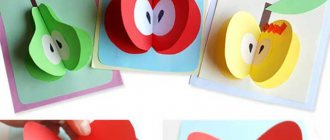How to conduct classes
Making each speech therapy session as effective as possible allows not only high-quality visual material, but also its correct use. There are several principles that are important to follow when working with pictures.
- Cards for children should have bright, realistic images drawn on a white background. It is better to use special kits for kindergarten; photography can also be useful.
- The younger the children, the more important it is to show images only of familiar, familiar objects.
- The number of pictures used in one lesson should correspond to the age of the child. For kids, 3-5 are enough; for older kids, you can take up to 10-15 cards.
- During the lesson, use subject and plot pictures on the same topic.
- First, you should introduce the children to the pictures, let them look at them well, and only then take the selected cards for educational games and activities.
Some information about vegetables...
The consumption of vegetables can be done depending on personal preferences. For lovers of raw foods, simply wash the treat and enjoy the pleasant or tart taste. During heat treatment, a partial loss of nutritional value occurs, but high-quality fortification and saturation with micro and macroelements occurs. Professional nutritionists say that vegetables should be consumed daily to maintain human health and stable functioning of the digestive tract. By storing root vegetables for the winter, you can provide yourself with the required substances during periods of immune deficiency that allow you to maintain a person’s vigorous state. In addition, vegetables are used for a variety of diets, and are also prescribed to patients after major surgery. The long processing process in the stomach ensures a feeling of fullness for a long time, while the complete distribution of nutrients in the human body occurs. Certain categories of root vegetables are indicated for people of different age groups. Young children are recommended to eat pumpkin to grow faster. Elderly people need celery to cleanse the body of foreign elements, eliminate problems with the gastrointestinal tract and stabilize blood circulation.
Tasks
If you want to use pictures on the topic “Vegetables” during speech therapy classes for children, you can offer the following assignment options:
- Pick and describe
The child must sort the images according to “what grows in the garden and in the garden”, and then tell in detail about one or several vegetables.
- List the characteristics of the object
A picture with a vegetable is selected. Then you need to list its characteristics (beets - burgundy, large, round, young, washed).
- Make up a story
Using a plot picture with vegetables, you can come up with a story on the theme “Harvesting” or “Little gardeners.”
Harvesting Little gardeners
- Come up with questions
Based on one subject picture with a vegetable, come up with as many questions as possible:
Where does it grow? What color does it come in? What does it resemble in shape? What dishes can be prepared from it?
- Describe the picture
Invite your child to talk about the vegetable he has on the card: list the external signs, where it grows, and in what form it is eaten.
- Lay it out and tell it
Ask them to sort the images into three groups: what grows underground, in the garden, on a bush.
Vegetables pictures for children - a selection, very cool and beautiful
In order to download a picture, you need to right- and select the “Save as...”
Then, using a data cable, Bluetooth or infrared port, download it to your phone.
Also see - Autumn pictures for children and toddlers - funny and beautiful Also see - Vegetables and fruits pictures for children - funny and beautiful
pristor.ru
Games
- What a harvest!
The players take turns taking one card with a picture of a vegetable and passing it around the circle, naming its characteristics. The last one to come up with an answer wins. Then the game is repeated again, but with a different card.
- Let's cook lunch
Each player chooses three pictures with vegetables. You need to correctly name the dish that can be prepared from each. Example:
eggplant, tomato, pumpkin - eggplant caviar, tomato soup, pumpkin juice; potatoes, zucchini, cucumber - mashed potatoes, zucchini pancakes, cucumber salad.
- What's extra?
Select four pictures so that three have something in common, and the fourth is superfluous. Example:
carrots-turnips-tomatoes-beets (all grow underground, but tomatoes do not) tomato-eggplant-radish-bell pepper (extra radishes, grow underground)
Older preschoolers can be offered more complex versions of this game:
tomato-potato-carrot-cucumber (potatoes are not eaten raw, they are extra).
- Writing riddles
Ask your child to choose one image from the Vegetables or Vegetable Garden set, and then make a wish for what is drawn. Children 3-4 years old are trained to describe only the features of an object from a selected picture, while older children can already come up with much more complex constructions, even short funny poems.
What are vegetables
Despite the fact that it is impossible to imagine any cuisine in the world without vegetables, the concept of “vegetable” is quite voluminous, broad with blurry, unclear boundaries. They are represented by more than 1200 species.
“Vegetables” is considered a culinary term - it is an edible part of plants or other plant food, excluding fruits, cereals, mushrooms, nuts, and edible algae. Sometimes they are equated with edible fruits, which in botany are equated with berries.
The definition of the Soviet vegetable grower, Professor V.I. is considered the most accurate. Edelstein, who called vegetables herbaceous plants that are cultivated for their edible juicy part. Vegetables are based on carbohydrates, but proteins and fats are practically absent. Plants are rich in vitamins, organic acids, fiber, pectins, micro-macroelements. This allows you to use vegetables for:
- Increasing energy levels, improving mood, normalizing psycho-emotional state.
- Saturation of the body with nutrients that are used by the body for the formation, renewal, and functioning of organs and cells.
- Removal of toxic compounds, toxins, carcinogens, bad cholesterol.
- Stimulates fat burning.
- Improving memory, maintaining a clear mind, mental activity.
- Regulation of blood sugar levels.
- Normalization of the cardiovascular system, prevention of heart attacks and strokes.
- Strengthening the body's defenses.
- Normal functioning of the gastrointestinal tract.
- Achieving antioxidant and anticancer effects.
The healing quality of vegetables also depends on phytonutrients - biologically active components that protect the plant from aggressive external influences and give it color. They enhance the anti-inflammatory, antiviral, antibacterial, detoxifying and other medicinal properties of vegetables. Eating vegetables of a certain color can achieve the following effects:
- green - rich in vitamins A, K, ascorbic, folic acids, chlorophyll, lutein, calcium. Plants prevent atherosclerosis, strengthen the immune, bone, respiratory
- system, contribute to the normalization of blood pressure;
- red - saturated with beta-carotene, lycopene, ascorbic acid. Have an anti-cancer effect, protect DNA, maintain the normal condition of blood vessels, beneficial
- affect the functioning of the gastrointestinal tract;
- yellow, orange - the content of beta-carotene and beta-cryptoxanthin affects the condition of the respiratory system, immunity, visual system, skin;
- blue, purple - saturated with anthocyanin and resveratrol. They give vegetables an anti-inflammatory effect, slow down aging, protect heart and brain cells;
- white - contain sulfur, allicin, quercetin. Helps normalize body weight, blood pressure, and strengthen the skeletal system. They have anti-inflammatory and anti-cancer effects.
The World Health Organization recommends eating at least 400g of vegetable products, of which at least 70% are fresh vegetables.
Vegetables cards | MOTHER AND BABY
Here you can download cards with images of vegetables . All “Vegetables” cards contain an image of a vegetable and its name: eggplant, broccoli, cabbage, potato, onion, carrot, cucumber, tomato, radish, beetroot, garlic, peas, zucchini, pepper, radish, turnip, cauliflower, pumpkin. You will also find cards from the educational series “The World in the Palm of Your Hand” and a thematic picture dictionary “Vegetables and Fruits”, which present options for activities on the topic “Vegetables”.









